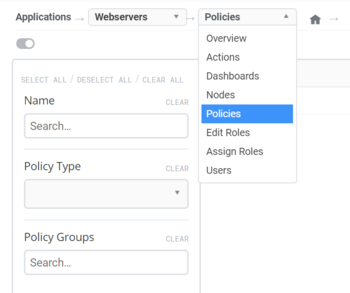Difference between revisions of "Policy"
m |
m (First version) |
||
| Line 4: | Line 4: | ||
== Overview == | == Overview == | ||
| − | Policies are created and edited in an [[application|application]]. A policy is instructions for the monitoring of something | + | Policies are created and edited in an [[application|application]]. A policy is instructions for the monitoring of something on a server. Policies are deployed to a server using [[group|groups]]. |
After entering an [[application|application]] use the [[Breadcrumbs|breadcrumb navigator]] to select the policies option to see the [[Policies_view|policies view]] | After entering an [[application|application]] use the [[Breadcrumbs|breadcrumb navigator]] to select the policies option to see the [[Policies_view|policies view]] | ||
Revision as of 23:00, 30 June 2020
Home > An Overview > Concepts > Policy
1 Overview
Policies are created and edited in an application. A policy is instructions for the monitoring of something on a server. Policies are deployed to a server using groups.
After entering an application use the breadcrumb navigator to select the policies option to see the policies view
2 Policy types
There are currently 14 different policy types. Each policy is targeted to monitor a different aspect of a server.
- Command execution runs an executable or script on a server and returns the result
- Disk / Filesystem monitors the used space and free space for a file system
- Event intercepts an event sent using veloopti-event.exe on the agent and inspect it for a match
- HTTP response monitors a webpage for key performance metrics
- Log file watches a log file for text matches or file size
- Ping response ping a host and inspect the return results
- Port availability watches the local or a remote host for the availability of a port
- Process performance watches a local process for key metrics
- Service status watches a local service for service state changes
- SNMP policy polls a SNMP device
- SNMP Trap recipient inspects a received SNMP trap
- Veloopti agent health monitors a Veloopti agent to see whether it is connected or not
- Windows performance library inspects the Windows Performance Library and returns the result
- CI Metric thresholds evaluates against metrics that are collected in the OS Application
3 Deploying a policy to a server
Policies are deployed to a server by adding it to a policy group. The policy group must also be linked to a node group that contains the server that the policy is to be deployed to.
One or more policies can be added to a policy group. A policy in a policy group is a member of the group. In order for the policies in the policy group to be deployed to the nodes in a node group the policy group must be linked to the node group. A policy group can be linked to one or more node groups. All nodes in the node group that have a policy group linked to it can have the policies deployed to them.
A policy group is located in an application and is not able to be linked to a node group outside of the application. A policy cannot be directly deployed to a node.
